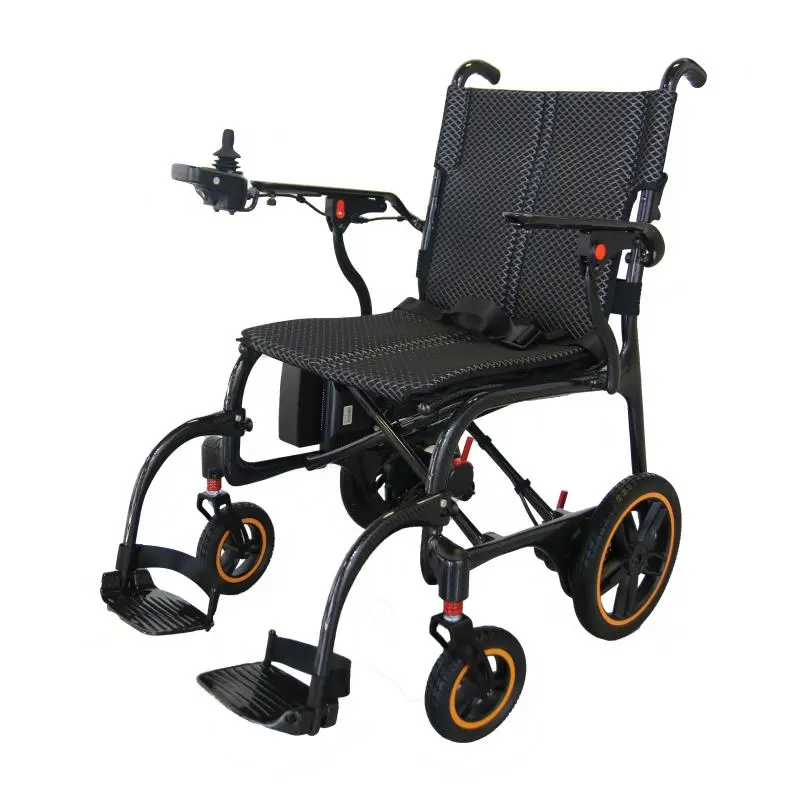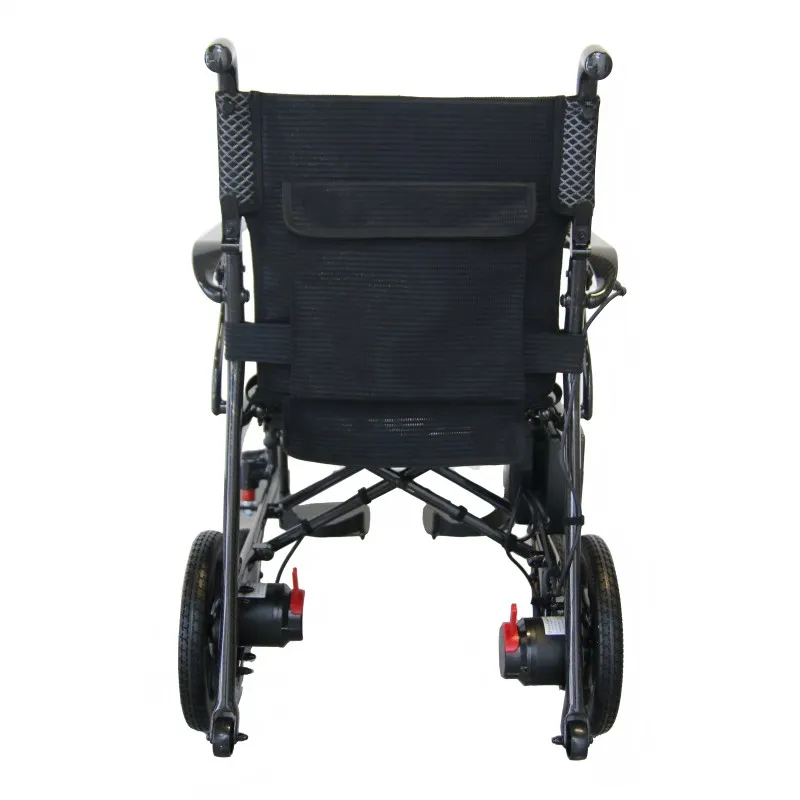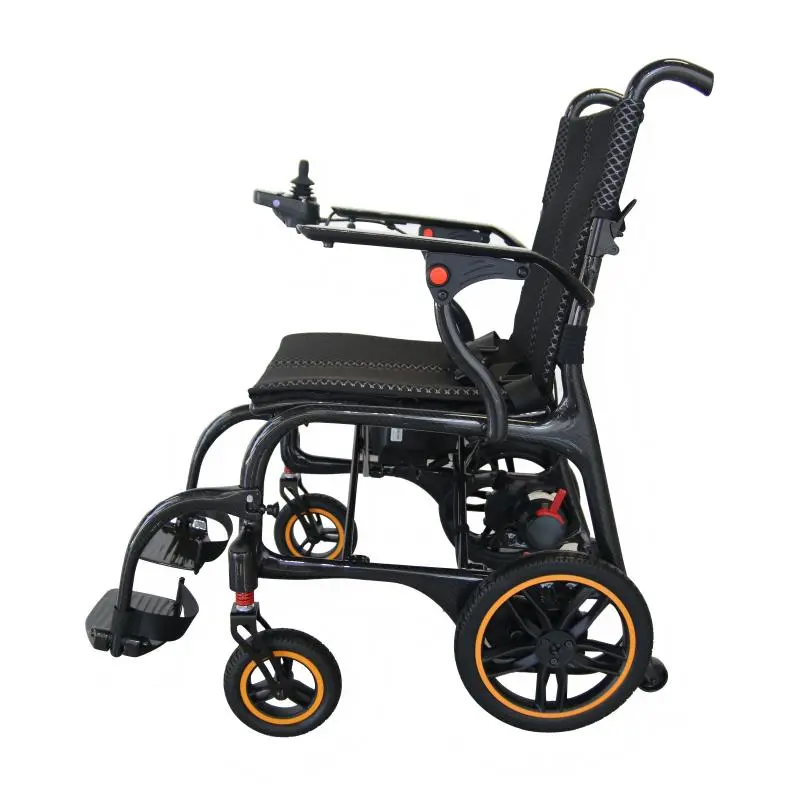Carbon fiber power wheelchairs are gaining increasing attention in the market due to their "lightweight, strong, and beautiful" qualities. However, the question of whether they are prone to breakage also arises: Is this material truly more fragile than aluminum or steel, and more likely to break during everyday use?
This article provides professional and actionable answers by reviewing the mechanical properties of carbon fiber materials and composite structures, common failure modes, international testing standards, non-destructive testing and repair pathways, and practical usage and procurement recommendations.

Are carbon fiber power wheelchairs "prone to breakage"?
Not "more prone to breakage," but rather "more prone to different types of fracture or latent damage."
Carbon fiber composites generally outperform aluminum alloys in tensile strength and specific strength, but their fracture mechanisms differ from metals—composite materials are more prone to delamination, matrix cracking, and fiber breakage, damage that is sometimes difficult to detect on the surface; while metals (such as aluminum) are more likely to exhibit plastic deformation and visible crack propagation.
In other words, carbon fiber power wheelchairs are not synonymous with fragility, but their hidden damage and sensitivity to impact/localized overload necessitate specialized design and maintenance management.
Why does the fracture behavior of carbon fiber power wheelchairs differ from that of aluminum and steel?
1. Different Material Properties
Carbon fiber composites consist of high-strength carbon fibers and a resin matrix. The fibers bear tensile loads, while the matrix bears shear and compression and protects the fibers. The high specific strength and specific stiffness of carbon fibers mean that they can be made stronger and stiffer for the same weight, but their impact resistance and localized compression resistance are often inferior to metals. Metals (such as aluminum) are ductile, often exhibiting obvious plastic deformation or bending before damage occurs, making them easy to visually detect and repair locally.
2. Anisotropy and Interlaminar Issues
The performance of carbon fibers is highly dependent on the layup direction and interlaminar bonding. If the layup design or curing process is inadequate, localized stress concentration or interlaminar separation can occur, leading to delamination under load or impact—this type of damage may not show surface cracks but significantly reduces load-bearing capacity.

What are the common types of fractures in carbon fiber power wheelchairs?
To answer the common question of "Is it prone to fracture?", it's essential to clarify "how it fractures and under what conditions." The following sections explain each failure type and provide practical judgment criteria.
1. Delamination
• Causes: Impact, localized indentation, resin curing defects or manufacturing contamination (including bubbles and inclusions) during the manufacturing process, and interfacial fatigue failure due to long-term fatigue.
• Characteristics: The surface may not show obvious cracks, but cavities or delamination can be detected by tapping or ultrasonic testing. For carbon fiber power wheelchairs, irregular "bulging" or repeated loosening in the same location after an impact should raise suspicion of delamination.
2. Matrix Cracks and Fiber Fracture
• Causes: Overload, sharp impact, or long-term low-cycle fatigue. Fiber fracture usually occurs in the fiber direction bearing the maximum stress.
• Characteristics: In severe cases, cracks and fiber fractures are visible at the cross-section; however, in the early stages, cracks may be deeply embedded in the interlayer and difficult to detect visually.
3. Localized Crushing/Honeycomb Core Failure (for sandwich structures)
• Cause: Localized high stress or impact damage causes core material failure (if a honeycomb or foam core layer is used).
• Characteristics: Surface collapse or localized reduction in hardness may occur, and the stiffness of the load-bearing section will significantly decrease.
4. Failure at Connection Points and Metal Inserts
• Cause: Carbon fiber components often use metal inserts as bolt connection points. Improper design can lead to stress concentration or electrochemical corrosion (in humid/salt-rich environments), resulting in connection failure.
• Characteristics: Loose bolts, chipped or cracked hole edges, or even insert pull-out. Good engineering practice involves using appropriate inserts, increasing the stress-bearing area, and employing both mechanical and adhesive designs at the connection points.
5. Systemic Electromagnetic/Grounding Issues (Indirect "Breakage" Risk)
• Cause: The conductivity of carbon fiber is mixed with the insulation of resin. If the vehicle is not properly grounded, it may affect motor control or cause minor malfunctions due to static electricity, indirectly increasing the risk of failure or misoperation.
• Characteristics: Controller malfunction, wireless interference, or intermittent power outages. Shielding and grounding paths must be considered in the battery/controller layout during engineering.
How do international and industry standards verify the issue of "prone to breakage"?
— ISO/RESNA Testing System.
Any judgment regarding "prone to breakage" must be linked to standardized test results. Core international tests for electric wheelchairs include static load, impact, fatigue, and environmental adaptability. The most commonly cited standards are the ISO 7176 series (covering static load, impact, and fatigue test methods) and relevant RESNA/ANSI standards.
If manufacturers can provide reports conforming to ISO 7176-8 (static, impact, and fatigue strength tests) and related documentation, they can objectively demonstrate whether the carbon fiber power wheelchair carries a risk of brittle fracture or premature failure under standard test conditions.
In other words: a qualified test report is more indicative of product durability and safety than the "material name."

Performance of Carbon Fiber Power Wheelchair in Testing and Real-World Scenarios
Recent academic and testing articles on carbon fiber wheelchairs indicate that, with proper design and process control, carbon fiber wheelchairs can compete with aluminum wheelchairs in vibration and fatigue testing, and even have significant advantages in vibration reduction and weight reduction; however, testing also emphasizes the importance of manufacturing quality and interlayer bonding.
Other studies have compared the differences between carbon fiber and aluminum frames in vibration reduction and dynamic excitation, suggesting that carbon fiber may perform better in certain dynamic responses, but requires special protection under extreme impacts or localized overloads.
In short, the "ease of breakage" of carbon fiber power wheelchairs is highly dependent on design, layup, curing process, and inspection control.
How to determine if a carbon fiber power wheelchair is damaged in daily use?
Hidden damage to carbon fiber power wheelchairs is a major concern for users. Below is a simple inspection procedure:
1. Visual Inspection
Observe the frame surface for obvious cracks, peeling, bulges, or abnormal coloring. Pay special attention to the area near bolt holes, folding hinges, and inserts.
2. Tap Test
Tap the suspected area lightly with a small, hard object (such as a pen cap). A dull thud or hollow sound compared to surrounding sounds may indicate interlayer delamination.
3. Functional Test
Drive over thresholds, turn, and change gears at normal speed, noting any unusual noises, sudden softening, or increased vibration.
4. Forced Inspection After Collision
If a drop or severe impact occurs, even if the exterior appears undamaged, stop using the product and request professional inspection (ultrasound or thermal imaging).
5. Regular Inspection
It is recommended to have a professional inspection performed every six months by an authorized service center, or follow the maintenance schedule in the manufacturer's manual.
What if the carbon fiber power wheelchair appears to be damaged?
1. Non-Destructive Testing (NDT) Methods
Ultrasonic testing (UT), thermal imaging, vibration modal analysis, acoustic wave transmission, and X-ray/CT (for small parts) can detect interlayer delamination, internal cracks, and defects. Ultrasound is a commonly used and efficient method in the field of composite materials. Thermal imaging is also widely used in localized delamination detection.
2. Repair Strategies
Minor interlayer delamination can sometimes be repaired using a patch + curing method, but this requires vacuum clamps, a suitable resin system, and curing conditions. Severe fiber breakage or damage to load-bearing components usually recommends complete replacement or replacement of the entire structure by the manufacturer. Remember: Unprofessional on-site glue application or sanding may mask defects and increase safety risks.
3. Liability and Warranty
Check the manufacturer's warranty terms to clarify the inspection and warranty policies after impact/drop. Many manufacturers do not provide free warranty coverage for "accidental impacts" but offer paid inspection and replacement services; choosing a brand with a local repair network and quick replacement parts supply can reduce the risk of downtime.

Carbon Fiber Power Wheelchair: Key Points for "Break Prevention" in Design and Manufacturing
To prevent carbon fiber power wheelchairs from "breaking easily," several key engineering measures are needed:
• Proper Ply Design: Distribute stress through directional plying (±45°, 0°, 90°) to avoid excessive load in any single direction.
• Metal Inserts and Transition Structures: Inserts or metal transition plates are used to distribute stress at bolt holes and load concentration areas, and corrosion-resistant isolation is provided at contact points.
• Sandwich/Reinforcing Rib Structures: Sandwich structures are used in demanding bending or compression areas to improve compressive and impact resistance.
• Surface Protection and Coatings: Weather-resistant, UV-resistant, and chemically resistant surface coatings are used to reduce substrate aging.
• Strict Quality Control and NDT Upon Arrival: The production line should have layered inspection, curing curve control, and ultrasonic/penetrating testing of random samples to ensure no manufacturing defects.
Does Dayang Medical provide wholesale supply for global markets?
Absolutely. Dayang Medical serves as a trusted supplier for customers in Europe, America, Asia, and other regions. Our product range includes electric wheelchairs, patient beds, shower chairs, walkers, and commodes, all available for wholesale supply. With our factory certifications (ISO13485, FDA, CE), buyers can confidently purchase safe and reliable products.
We support large-volume orders with discounts, provide detailed factory quotes, and offer promotional prices for long-term partners.










